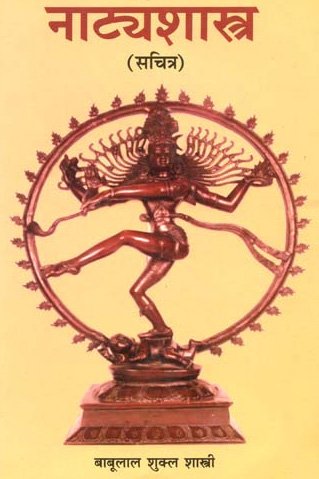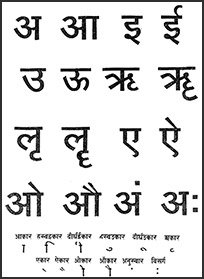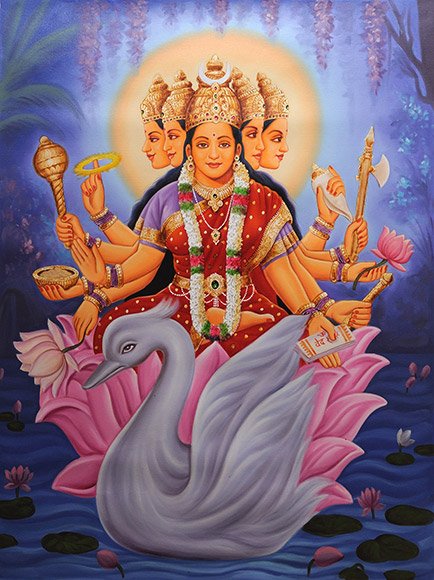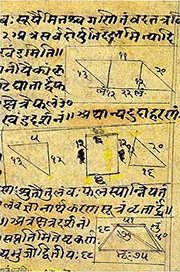Asti, Aṣṭi, Ashti: 19 definitions
Introduction:
Asti means something in Hinduism, Sanskrit, the history of ancient India, Marathi, Hindi, biology, Tamil. If you want to know the exact meaning, history, etymology or English translation of this term then check out the descriptions on this page. Add your comment or reference to a book if you want to contribute to this summary article.
The Sanskrit term Aṣṭi can be transliterated into English as Asti or Ashti, using the IAST transliteration scheme (?).
Images (photo gallery)
In Hinduism
Purana and Itihasa (epic history)
Source: archive.org: Puranic EncyclopediaAstī (अस्ती).—Daughter of Jarāsandha, King of Magadha. Kaṃsa married Astī and also another daughter of Jarāsandha. (Ślokas 29 to 32, Chapter 14, Sabhā Parva, Mahābhārata). Chapter 12 of Agni Purāṇa states that Jarāsandha went to war with the Yādavas because of the persuasion of these daughters.
Source: Cologne Digital Sanskrit Dictionaries: The Purana IndexAsti (अस्ति).—Daughter of Jarāsandha and a queen of Kaṃsa. After her husband's death she went to her father's place and reported the circumstances in which her husband was killed.*
- * Bhāgavata-purāṇa X. 50. 1-2; Viṣṇu-purāṇa V. 22. 1.

The Purana (पुराण, purāṇas) refers to Sanskrit literature preserving ancient India’s vast cultural history, including historical legends, religious ceremonies, various arts and sciences. The eighteen mahapuranas total over 400,000 shlokas (metrical couplets) and date to at least several centuries BCE.
Natyashastra (theatrics and dramaturgy)
Source: Wisdom Library: Nāṭya-śāstraAṣṭi (अष्टि) refers to a class of rhythm-type (chandas) containing sixteen syllables in a pāda (‘foot’ or ‘quarter-verse’), according to the Nāṭyaśāstra chapter 15. There are twenty-six classes of chandas and out of them arise the various syllabic meters (vṛtta), composed of four pādas, defining the pattern of alternating light and heavy syllables.

Natyashastra (नाट्यशास्त्र, nāṭyaśāstra) refers to both the ancient Indian tradition (shastra) of performing arts, (natya—theatrics, drama, dance, music), as well as the name of a Sanskrit work dealing with these subjects. It also teaches the rules for composing Dramatic plays (nataka), construction and performance of Theater, and Poetic works (kavya).
Vyakarana (Sanskrit grammar)
Source: Wikisource: A dictionary of Sanskrit grammarAṣṭi (अष्टि).—Name of a metre of four feet consisting of 64 syllables in all, 12 syllables in the odd feet and 20 in the even feet; e. g. त्रिकद्रुकेषु महिषः (trikadrukeṣu mahiṣaḥ) etc. R.V. II.22.1.

Vyakarana (व्याकरण, vyākaraṇa) refers to Sanskrit grammar and represents one of the six additional sciences (vedanga) to be studied along with the Vedas. Vyakarana concerns itself with the rules of Sanskrit grammar and linguistic analysis in order to establish the correct context of words and sentences.
Chandas (prosody, study of Sanskrit metres)
Source: Shodhganga: a concise history of Sanskrit Chanda literatureAṣṭi (अष्टि) is one of the twenty-six varieties of Sanskrit metres (chandas) mentioned in the Chandaśśāstra 1.15-19. There are 26 Vedic metres starting with 1 to 26 letters in each pāda. It is a common belief that the classical metres are developed from these 26 metres. Generally a metre has a specific name according to it’s number of syllables (akṣara). But sometimes the same stanza is called by the name of another metre from the point of view of the pādas.

Chandas (छन्दस्) refers to Sanskrit prosody and represents one of the six Vedangas (auxiliary disciplines belonging to the study of the Vedas). The science of prosody (chandas-shastra) focusses on the study of the poetic meters such as the commonly known twenty-six metres mentioned by Pingalas.
Ganitashastra (Mathematics and Algebra)
Source: archive.org: Hindu MathematicsAṣṭi (अष्टि) represents the number 16 (sixteen) in the “word-numeral system” (bhūtasaṃkhyā), which was used in Sanskrit texts dealing with astronomy, mathematics, metrics, as well as in the dates of inscriptions and manuscripts in ancient Indian literature.—A system of expressing numbers by means of words arranged as in the place-value notation was developed and perfected in India in the early centuries of the Christian era. In this system the numerals [e.g., 16—aṣṭi] are expressed by names of things, beings or concepts, which, naturally or in accordance with the teaching of the Śāstras, connote numbers.

Ganitashastra (शिल्पशास्त्र, gaṇitaśāstra) refers to the ancient Indian science of mathematics, algebra, number theory, arithmetic, etc. Closely allied with astronomy, both were commonly taught and studied in universities, even since the 1st millennium BCE. Ganita-shastra also includes ritualistic math-books such as the Shulba-sutras.
India history and geography
Source: Cologne Digital Sanskrit Dictionaries: Indian Epigraphical GlossaryAsti.—(Ep. Ind., Vol XXVIII, p. 302, note 2), a mere particle used to introduce the narration of a grant. Note: asti is defined in the “Indian epigraphical glossary” as it can be found on ancient inscriptions commonly written in Sanskrit, Prakrit or Dravidian languages.
--- OR ---
Aṣṭi.—(IE 7-1-2), ‘sixteen’. Note: aṣṭi is defined in the “Indian epigraphical glossary” as it can be found on ancient inscriptions commonly written in Sanskrit, Prakrit or Dravidian languages.

The history of India traces the identification of countries, villages, towns and other regions of India, as well as mythology, zoology, royal dynasties, rulers, tribes, local festivities and traditions and regional languages. Ancient India enjoyed religious freedom and encourages the path of Dharma, a concept common to Buddhism, Hinduism, and Jainism.
Biology (plants and animals)
Source: Google Books: CRC World Dictionary (Regional names)Asti in India is the name of a plant defined with Ficus arnottiana in various botanical sources. This page contains potential references in Ayurveda, modern medicine, and other folk traditions or local practices It has the synonym Pogonotrophe emodi Miq. (among others).
Example references for further research on medicinal uses or toxicity (see latin names for full list):
· Numer. List (4515)
· Ann. Mus. Bot. Lugduno-Batavi (1867)
· London Journal of Botany (1848)
· London Journal of Botany (1847)
If you are looking for specific details regarding Asti, for example health benefits, chemical composition, side effects, diet and recipes, pregnancy safety, extract dosage, have a look at these references.

This sections includes definitions from the five kingdoms of living things: Animals, Plants, Fungi, Protists and Monera. It will include both the official binomial nomenclature (scientific names usually in Latin) as well as regional spellings and variants.
Languages of India and abroad
Marathi-English dictionary
Source: DDSA: The Molesworth Marathi and English Dictionaryastī (अस्ती).—f (Corr. from asthi) A bone.
Marathi is an Indo-European language having over 70 million native speakers people in (predominantly) Maharashtra India. Marathi, like many other Indo-Aryan languages, evolved from early forms of Prakrit, which itself is a subset of Sanskrit, one of the most ancient languages of the world.
Sanskrit dictionary
Source: DDSA: The practical Sanskrit-English dictionaryAṣṭi (अष्टि).—f. [asyate bhūmau kṣipyate as-ktin pṛṣo° ṣatvam]
1) A die for playing.
2) A metre consisting of sixty-four syllables.
3) [akṣ-vyāptau-ktin] Pervasion, reaching (Ved.) इन्द्रं शुम्भास्म्यष्टये (indraṃ śumbhāsmyaṣṭaye) Av.6.54.1.
4) The body (the instrument of enjoyment).
5) The number sixteen.
6) Seed.
7) Kernel. कन्दाष्टिभिर्मूलफलैः (kandāṣṭibhirmūlaphalaiḥ) Bhāgavata 4.28.36.
Derivable forms: aṣṭiḥ (अष्टिः).
--- OR ---
Asti (अस्ति).—ind. [as-śatip]
1) Being, existent, present; as in अस्तिक्षीरा, °कायः (astikṣīrā, °kāyaḥ)
2) Often used at the commencement of a tale or narrative in the sense of 'so it is', 'there', or merely as an expletive; अस्ति सिंहः प्रतिवसति स्म (asti siṃhaḥ prativasati sma) Pañcatantra (Bombay) 4; अस्त्यत्र नगरे (astyatra nagare)...त्रयः पुरुषा देवस्य श्रियं न सहन्ते (trayaḥ puruṣā devasya śriyaṃ na sahante) Mu. 1,5; अस्ति पूर्वमहं व्योमचारी विद्याधरोऽभवम् (asti pūrvamahaṃ vyomacārī vidyādharo'bhavam) Kathāsaritsāgara 22.56,1. 27; अस्ति तत्रभवान् वृषलं याजयिष्यति (asti tatrabhavān vṛṣalaṃ yājayiṣyati) P.III.3.146 is it that &c.
-stiḥ f. Name of a sister of Prāpti, daughter of Jarāsandha and wife of Kaṃsa.
Source: Cologne Digital Sanskrit Dictionaries: Shabda-Sagara Sanskrit-English DictionaryAṣṭī (अष्टी).—f. (-ṣṭī) A metre consisting of four lines, and having sixteen syllables in each; there are nine species of it. E. aṣṭan eight, ṅīp fem. aff.
--- OR ---
Asti (अस्ति).—ind. Now being, existent, present. E. asa to be, and ktin affix, or the third person sing. present tense, it is, used as a particle.
Source: Cologne Digital Sanskrit Dictionaries: Cappeller Sanskrit-English DictionaryAṣṭi (अष्टि).—1. [feminine] reaching.
--- OR ---
Aṣṭi (अष्टि).—2. [feminine] [Name] of a class of metres.
--- OR ---
Aṣṭi (अष्टि).—3. [feminine] grain of seed.
Source: Cologne Digital Sanskrit Dictionaries: Monier-Williams Sanskrit-English Dictionary1) Aṣṭi (अष्टि):—[from aṣṭan] 1. aṣṭi f. Name of a metre consisting of sixty-four syllables (like that in [Ṛg-veda ii, 22, 1; Ṛgveda-prātiśākhya])
2) [v.s. ...] the number, ‘sixteen’ [Sūryasiddhānta]
3) 2. aṣṭi f. (√1. aś), reaching, [Atharva-veda vi, 54, 1] (cf. jarad-aṣṭi, vyaṣṭi, samaṣṭi.)
4) 3. aṣṭi f. (= asthi q.v.) the kernel or stone of a fruit, [Bhāgavata-purāṇa]
5) Asti (अस्ति):—1. asti ind. (3. sg. pr. √1. as; [gana] cādi and svar-ādi q.v.) sometimes used as a mere particle at the beginning of fables, [Pañcatantra; Kathāsaritsāgara]
6) existent, present, [cf. Lexicographers, esp. such as amarasiṃha, halāyudha, hemacandra, etc.]
7) 2. asti f. (as-ti = s-ti q.v.), Name of a sister of Prāpti (daughter of Jarāsandhas and wife of Kaṃsa), [Mahābhārata ii, 595; Harivaṃśa 4955; Bhāgavata-purāṇa]
Source: Cologne Digital Sanskrit Dictionaries: Yates Sanskrit-English DictionaryAsti (अस्ति):—— ind. Being; it is.
Source: DDSA: Paia-sadda-mahannavo; a comprehensive Prakrit Hindi dictionary (S)Asti (अस्ति) in the Sanskrit language is related to the Prakrit word: Atthi.
[Sanskrit to German]
Sanskrit, also spelled संस्कृतम् (saṃskṛtam), is an ancient language of India commonly seen as the grandmother of the Indo-European language family (even English!). Closely allied with Prakrit and Pali, Sanskrit is more exhaustive in both grammar and terms and has the most extensive collection of literature in the world, greatly surpassing its sister-languages Greek and Latin.
Hindi dictionary
Source: DDSA: A practical Hindi-English dictionary1) Asti (अस्ति):—(nf) existence; being.
2) Āsti (आस्ति):—(nf) property, estate; asset.
...
Kannada-English dictionary
Source: Alar: Kannada-English corpusAṣṭi (ಅಷ್ಟಿ):—
1) [noun] (pros.) a metre having four lines of sixteen syllables each.
2) [noun] a seed pod; the stone of fruit (as of mango).
3) [noun] name of a musical mode, a derived from the main mode Varuṇapriya, in Karnāṭaka system.
--- OR ---
Asti (ಅಸ್ತಿ):—
1) [noun] the state or fact of existing or living; being.
2) [noun] (vīr .) vibrations in air, water, etc. that stimulate the auditory nerves and produce the sensation of hearing; the sound.
--- OR ---
Āsti (ಆಸ್ತಿ):—[noun] anything owned that has exchange value; property; possessions; capital; asset or assets; an estate.
Kannada is a Dravidian language (as opposed to the Indo-European language family) mainly spoken in the southwestern region of India.
See also (Relevant definitions)
Starts with (+51): Ashtin, Asti-carapeti, Asti-coparokam, Asti-nastivatam, Astibala, Astibalayana, Astibhaksha, Astibhara, Astichinta, Asticinta, Asticuram, Astigara, Astik, Astika, Astikajanani, Astikan, Astikaparva, Astikarthada, Astikata, Astikate.
Ends with (+306): Aagasti, Abhishasti, Abhyantarashatshashti, Abutilon theophrasti, Acarabhrashti, Adanavasti, Adavasti, Adhihasti, Adhiprashti, Agasti, Aghapancashashti, Aghapanchashashti, Ainadasti, Aishikahasti, Ajavasti, Akhiri-basti, Akkasti, Amalamasti, Ambasti, Amdhayashti.
Full-text (+249): Atyashti, Astimat, Astinasti, Astayana, Astikaya, Atyashtisamagri, Asthi, Astitva, Astikshira, Astipravada, Astika, Pravaralalita, Samashtita, Vyashtisamashtita, Ashthilika, Svastida, Madanalalita, Svastikarman, Svastivada, Anthala.
Relevant text
Search found 106 books and stories containing Asti, Aṣṭi, Ashti, Astī, Aṣṭī, Āṣṭi, Āsti, Aasti; (plurals include: Astis, Aṣṭis, Ashtis, Astīs, Aṣṭīs, Āṣṭis, Āstis, Aastis). You can also click to the full overview containing English textual excerpts. Below are direct links for the most relevant articles:
Garga Samhita (English) (by Danavir Goswami)
Verse 4.6.12 < [Chapter 6 - The Story of the Ayodhyā Women]
Verse 5.8.47 < [Chapter 8 - The Killing of Kaṃsa]
Verse 1.6.14 < [Chapter 6 - Description of Kaṃsa’s Strength]
Rig Veda (translation and commentary) (by H. H. Wilson)
Amarakoshodghatana of Kshirasvamin (study) (by A. Yamuna Devi)
Education (8): Knowledge of Metres and Figures of speech < [Chapter 4 - Cultural Aspects]
Consciousness in Gaudapada’s Mandukya-karika (by V. Sujata Raju)
How the Ātman is obscured by the ignorant < [Chapter 6: A Study of Māṇḍūkya Kārikā: Alātaśānti Prakaraṇa]
The non-originated, non-relational, ever-enlightened Consciousness < [Chapter 6: A Study of Māṇḍūkya Kārikā: Alātaśānti Prakaraṇa]
Critique of various theories of causation < [Chapter 6: A Study of Māṇḍūkya Kārikā: Alātaśānti Prakaraṇa]
Trishashti Shalaka Purusha Caritra (by Helen M. Johnson)
Natyashastra (English) (by Bharata-muni)
